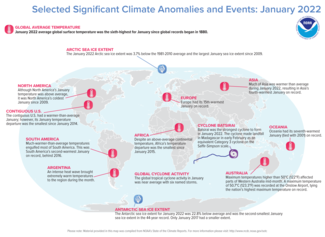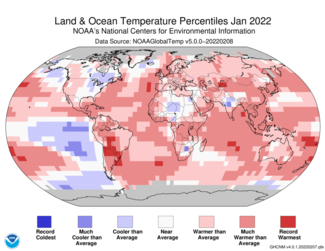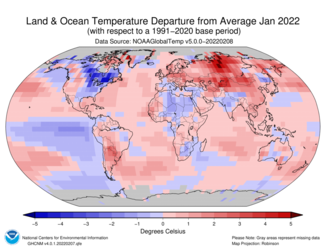Sixth-warmest January on record for the globe; second-smallest Antarctic January sea ice extent

The global temperature for January 2022 was the sixth highest for January in the 143-year NOAA record, which dates back to 1880. According to NCEI’s Global Annual Temperature Rankings Outlook, it is virtually certain (> 99.0%) that the year 2022 will rank among the 10 warmest years on record.
This monthly summary, developed by scientists at NOAA’s National Centers for Environmental Information, is part of the suite of climate services NOAA provides to government, business, academia and the public to support informed decision-making.
Monthly Global Temperature
The January 2022 global surface temperature was 1.60°F (0.89°C) above the 20th-century average of 53.6°F (12.0°C) and ranked as the sixth-warmest January in the 143-year record. January 2022 also marked the 46th consecutive January and the 445th consecutive month with temperatures, at least nominally, above the 20th-century average.
Temperatures were much above average across most of South America, resulting in its second-warmest January on record. Only January of 2016 was warmer. Much of the Atlantic, northern Indian, and western Pacific oceans, as well as parts of southern North America, western and southern Africa, and southern Asia had much-above-average temperatures. Meanwhile, cooler-than-average temperatures were observed across parts of northern North America, northern Africa, India, and the Pacific Ocean.
Asia, as a whole, had its fourth-warmest January on record, while Oceania’s January temperature departure tied with 2001 as the seventh highest on record. Despite North America and Africa’s above-average January temperature, they had their coldest January since 2009 and 2015, respectively.
Sea Ice and Snow Cover
According to data from NOAA and analysis by the Rutgers Global Snow Lab, the Northern Hemisphere snow cover extent during January was slightly above the 1981-2010 average at 18.26 million square miles. This was the largest January snow cover extent since 2017. North America had near-average January snow cover extent, while Eurasia had slightly above-average January snow cover extent.
The January 2022 Arctic sea ice extent averaged 5.36 million square miles, which is 208,000 square miles below the 1981-2010 average. Although the monthly sea ice extent was below average for the month, it was the largest January extent since 2009. According to the National Snow and Ice Data Center (NSIDC), regional sea ice extent was below average in the Sea of Okhotsk, Barents Sea, and the Gulf of St. Lawrence, while the Bering Sea had above-average extent for the month.
The Antarctic sea ice extent for January 2022 was the second smallest January sea ice extent in the 44-year record at 1.49 million square miles, which is 440,000 square miles below average. Only January of 2017 had a smaller sea ice extent at 470,000 square miles below average.
Global Tropical Cyclones
Six tropical storms formed globally in January, which is near normal. However, most of them were weak, so the accumulated cyclone energy (ACE: an integrated metric of the strength, frequency, and duration of tropical storms) was the third lowest since 1981. The Northern Hemisphere had no tropical cyclone activity during January 2022, which is not unusual. In the Southern Hemisphere, the strongest cyclone that formed during the month was Major Cyclone Batsirai, which made landfall in Madagascar in early February as an equivalent Category 3 cyclone on the Saffir-Simpson scale.
For a more complete summary of climate conditions and events, see our January 2022 Global Climate Report.



